About 200 scientists from more than 30 countries joined September 4-7 in Münster for discussing the "Progress in Analytical Methodologies for Trace Metal Speciation".
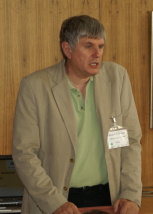 The
TraceSpec'07 workshop started with a short course given by Olivier F.X. Donard from
the University of
Pau. The audience (about 35 participants) especially appreciated the numerous practical hints from
within the laboratory that highlighted the practical problems that analysts have
to face with speciation analysis of real complex samples.
The
TraceSpec'07 workshop started with a short course given by Olivier F.X. Donard from
the University of
Pau. The audience (about 35 participants) especially appreciated the numerous practical hints from
within the laboratory that highlighted the practical problems that analysts have
to face with speciation analysis of real complex samples.
Photo 1: Olivier F.X. Donard giving a short course on speciation analysis - the practical way
At the
evening of the day, the exhibition of manufacturers and suppliers was opened to
the public with a get-together mixer. The attractive exhibition of
companies (see exhibitors at TraceSpec)
providing instrumentation dedicated to speciation analysis (mainly LC-ICP-MS,
GC-ICP-MS, GC-AFS and GC-MIP-AES) or supporting the field with accessories was
open during the whole workshop and allowed for intensive contacts between the
exhibitors and their potential customers. The foyer of the "Schloß"
created a very nice atmosphere for the exhibition and coffee and lunch breaks
were served in the exhibition area to intensify the contact possibilities
during the dense scientific program of the workshop.
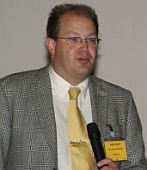 The main
workshop was opened the other day by the organizers, namely by Uwe Karst (University of Münster), Dieter Klockow (IAEAC) and
Michael Sperling (EVISA) in the historical "Aula" of the
"Schloß".
The main
workshop was opened the other day by the organizers, namely by Uwe Karst (University of Münster), Dieter Klockow (IAEAC) and
Michael Sperling (EVISA) in the historical "Aula" of the
"Schloß".
Photo 2: Uwe Karst opening the workshop on behalf of the University of Münster
Sessions of the following single stream program consisting
of invited lectures and oral contributions were related to the main research
fields, namely Environmental speciation analysis, speciation analysis for the
food and health sector, development of tools for speciation analysis, In-situ
speciation analysis and speciation analysis in proteomics, metallomics and
metabolomics. The scene for each of these topics was set by an invited lecture,
giving either an overview or presenting important contributions for the
development of speciation methodology. Most of the attendees participated
actively by giving either an oral lecture (43) or by presenting a poster (83).
Olivier
Donard (University of Pau, France) started the first session
on Environmental speciation analysis.He
highlighted the fact that environmental chemistry mainly has to deal with
molecules rather than elements and that some of the molecules such as humic
acids are rather big with complicated structure. He also gave some examples,
how modelling can help to predict the behaviour of the molecules with respect
to bioavailability and toxicity. He further stressed the point that existing
legislation such as REACH demands to go beyond total element analysis and
requires discussing the species as they will appear in the environment.
The
following session of contributed papers covered a broad variety of aspects of
environmental speciation analysis. Petra Krystek (formerly RIVM) discussed the chromium(VI) pollution originating from a foundry close to a living area in the
Netherlands.
The main problem for sampling was the necessity to cover the different working
conditions of the foundry as well as the meteorological conditions.
Markus Lenz
(Wageningen University) demonstrated how speciation
analysis helps to optimize bioremediation of selenium containing waters. María
Jiménez Moreno discussed the problem of species interconversion occurring
during the analysis of mercury species in contaminated sediments and its
circumvention through appropriate separation methodology.
The coffee break was used to further discuss the presentations and to visit the exhibition area.
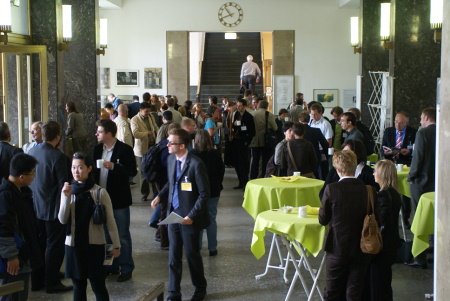
Photo 3: Coffee-break in the foyer of the Münster "Schloss"
After the coffee break the session was continued by Patrick Thomas (Institute Pasteur) who discussed the validation of speciation methods for routine analysis. Hans A. van der Sloot (Energy Research Centre of the Netherlands, ECN, The Netherlands) discussed the prediction of the leaching behaviour by modelling and pH dependence leaching test. Ruth E. Wolf (United States Geological Survey, Denver, USA) discussed the interest of USGS in speciation analysis and gave an example for simultaneous multielement speciation analysis. Shona McSheehy (Thermo Fisher Scientific Bremen, Germany) ended the morning session with a contribution highlighting the sensitivity and selectivity of GC-ICP-MS for the determination of PBDEs.
The lunch break took again place in the foyer and gave ample time to visit the exhibition.
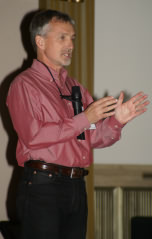 The afternoon session was dedicated to the food and health sector, and Erik Larsen (National Food Institute, Technical University of Denmark, Søborg, Denmark) gave a brief overview about the role of trace element speciation in life-science research. He particularly emphasized the role that speciation analysis plays for elucidating the biological function of essential trace elements such as selenium or for following the exposure routes of toxic species such as inorganic arsenic or methylmercury. A further example was related to the health hazards related to nanoparticles.
The afternoon session was dedicated to the food and health sector, and Erik Larsen (National Food Institute, Technical University of Denmark, Søborg, Denmark) gave a brief overview about the role of trace element speciation in life-science research. He particularly emphasized the role that speciation analysis plays for elucidating the biological function of essential trace elements such as selenium or for following the exposure routes of toxic species such as inorganic arsenic or methylmercury. A further example was related to the health hazards related to nanoparticles.
Photo 4: Eric Larsen
The following submitted contributions concentrated on the development of methods for the food and health sector. Emma Warburton (LGC Ltd., Middlesex, UK) showed that microwave-assisted extraction can be used to speed-up extraction of selenium from yeast without degrading the organic selenium species. Claudia Swart (Federal Institute for Materials Research and Testing (BAM), Berlin, Germany) discussed contamination and preservation problems related to the speciation analysis of arsenic in water samples. Her results indicated that sample vials have to be chosen carefully in order to avoid gross contamination errors. The first part of the afternoon session ended with a contribution by Patcharin Jankong (Mahidol University Bangkok, Thailand), who discussed the arsenic speciation in freshwater fish from contaminated sites. Her results indicated that arsenic in the fish correlates with arsenic in the water body and that the non-toxic arsenobetaine is only a minor species in the studied freshwater fish.
The following coffee break was used to visit the poster session I dedicated to Environmental studies / Studies in the field of Biosciences.
 Photo 5: Poster session I
Photo 5: Poster session I
More than 40 posters were intensively discussed by the participants and also by the members of the poster jury that had to find the "best" posters with respect to novelty, clarity and presentation for the poster awards sponsored by Thermo Scientific, AHF, Perkin-Elmer and PS Analytical.
After the coffee-break the session was continued with a contribution by
Erwin Rosenberg (Technical University of Vienna, Austria) who discussed the contributions of different speciation techniques to the elucidation of the structure of germanium sesquioxide. Stefan Trümpler (University of Münster, Germany) presented his work on the development and application of a new plasma emission detector for the speciation analysis of mercury. The session was ended with a contribution by Petra Cuderman (Jozef Stefan Institute Ljubljana, Slovenia). She discussed the determination of selenium species in Se-enriched potatoes.
After such a long working day the social program for the evening was highly appreciated. To a great extend the participants followed the invitation to visit the Münster planetarium for a totally different presentation (Discovery of the Southern Hemisphere). A short walk from the planetarium to the open-air museum "Mühlenhof" provided some fresh air and allowed for a short view on a "hidden church" in Münster, another example for the viewpoint that new things can be discovered beneath the surface. Arriving at the Mühlenhof, the participants were welcomed by the "Kiepenkerl", a typical personality of Münster with a sample of the local "Schnaps". The following dinner in the warm atmosphere of the typical rooms of the historical farmhouse created the environment for intense discussions between the participants, this time not only speciation related.
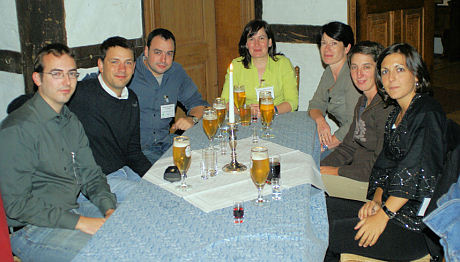
Photo 6: Westphalian evening at
the "Mühlenhof"
 continued on page 2
continued on page 2